Abstract
Three experiments were conducted with pigeons to examine the role of the signal in delay-of-reinforcement procedures. In the first, a blackout accompanying a period of nonreinforcement increased key-peck response rates maintained by immediate reinforcement. The effects of dissociating the blackout from the delay interval were examined in the second experiment. In three conditions, blackouts and unsignaled delays were negatively correlated or occurred randomly with respect to one another. A signaled delay and an unsignaled delay that omitted the blackouts were studied in two other conditions. All delay-of-reinforcement conditions generally produced response rates lower than those produced by immediate reinforcement. Signaled delays maintained higher response rates than did any of the various unsignaled-delay conditions, with or without dissociated blackouts. The effects of these latter conditions did not differ systematically from one another. The final experiment showed that response rates varied as a function of the frequency with which a blackout accompanied delay intervals. By eliminating a number of methodological difficulties present in previous delay-of-reinforcement experiments, these results suggest the importance of the signal in maintaining responding during delay-of-reinforcement procedures and, conversely, the importance of the delay interval in decreasing responding.
Keywords: signal functions, delay of reinforcement, blackout, variable-interval schedules, key peck, pigeons
Full text
PDF

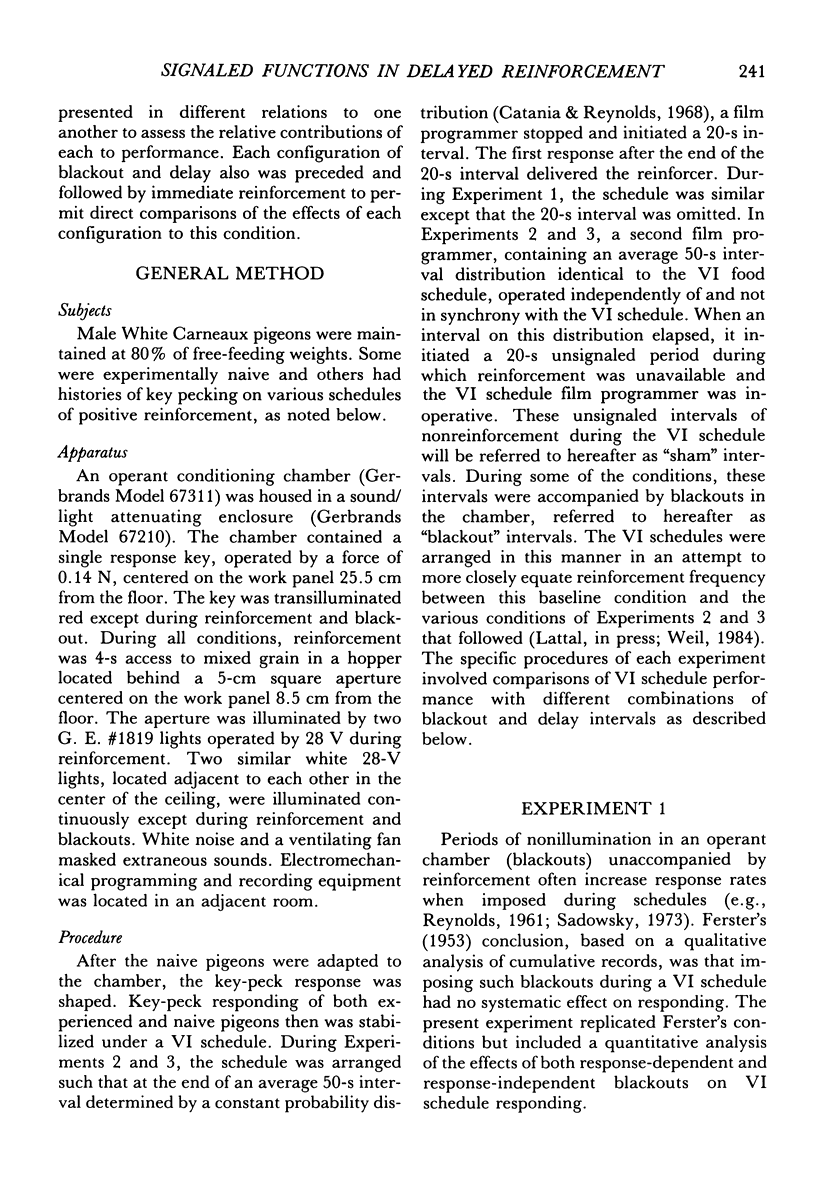
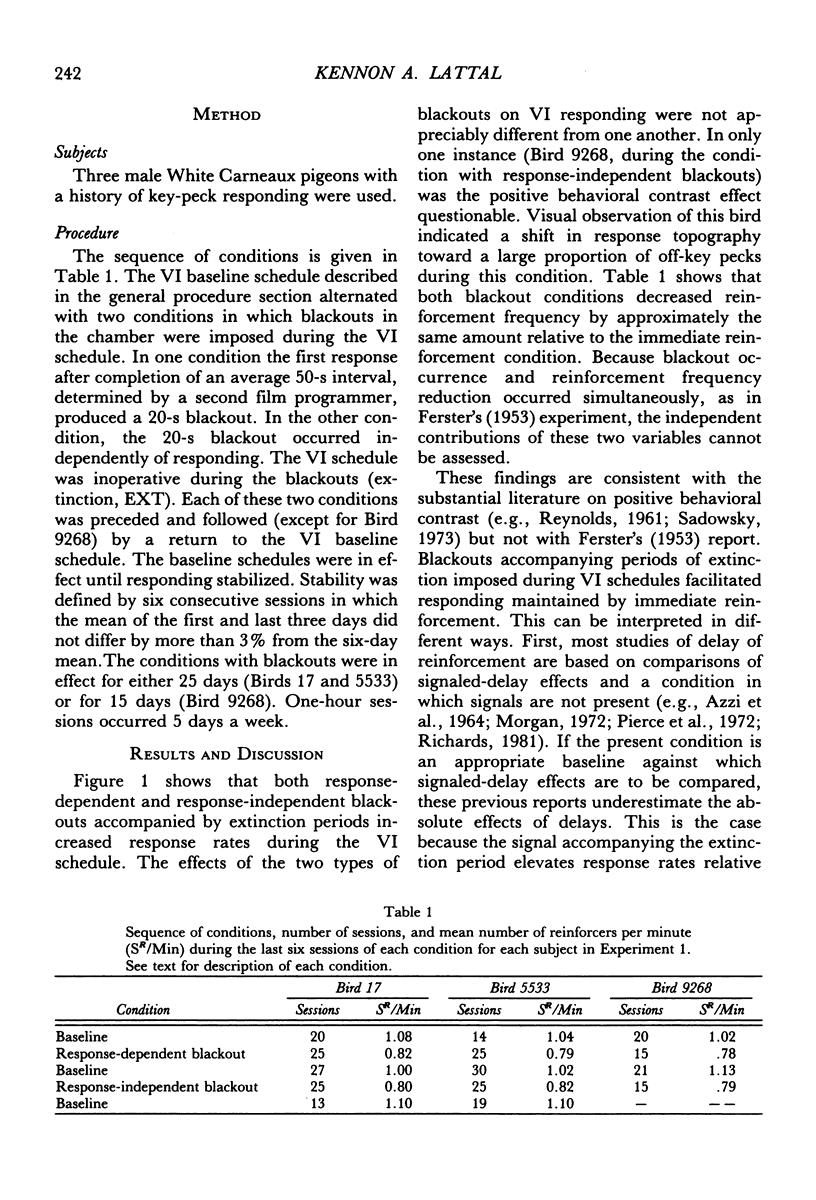
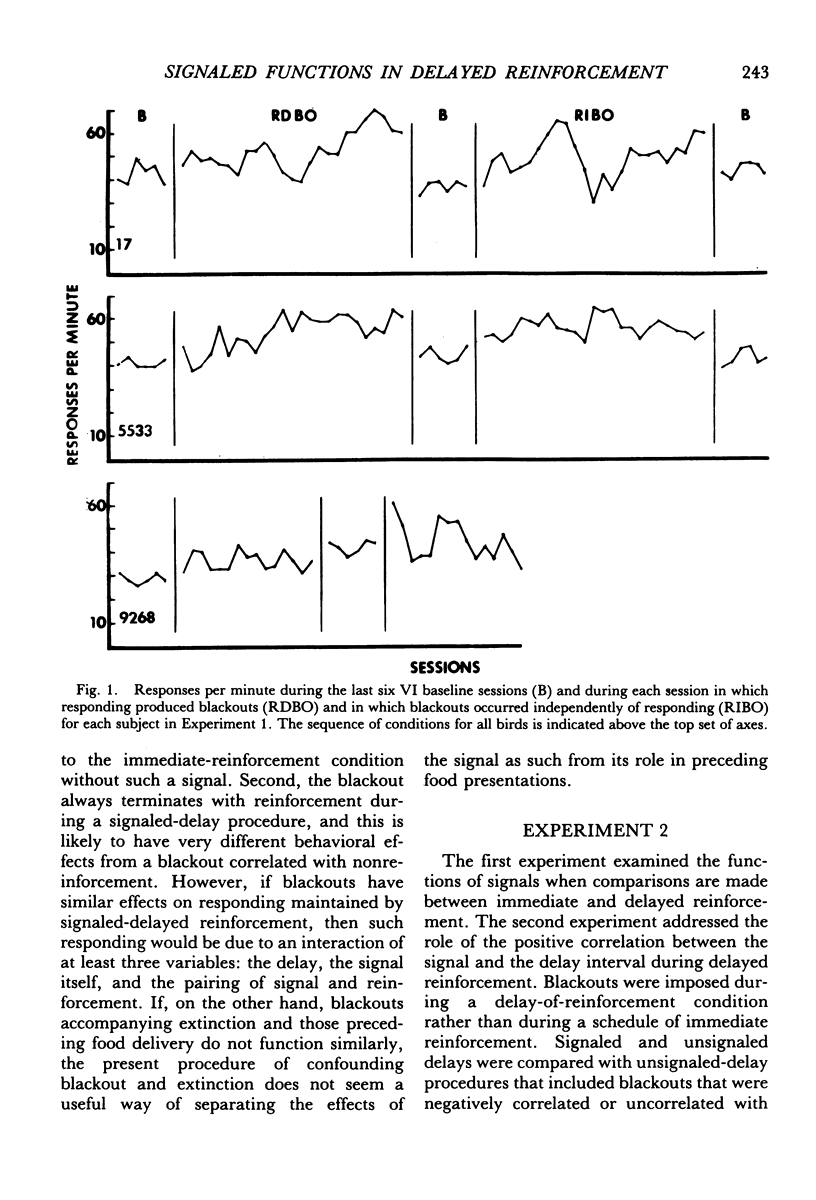
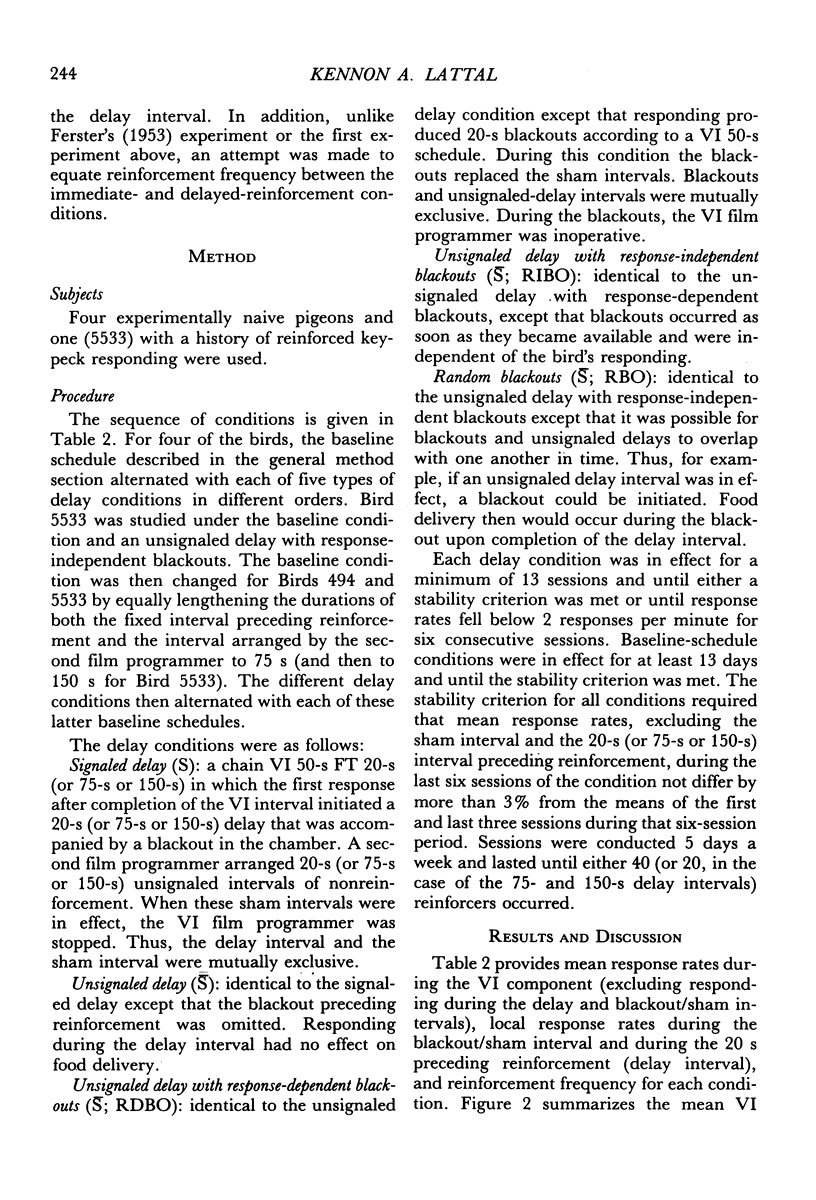
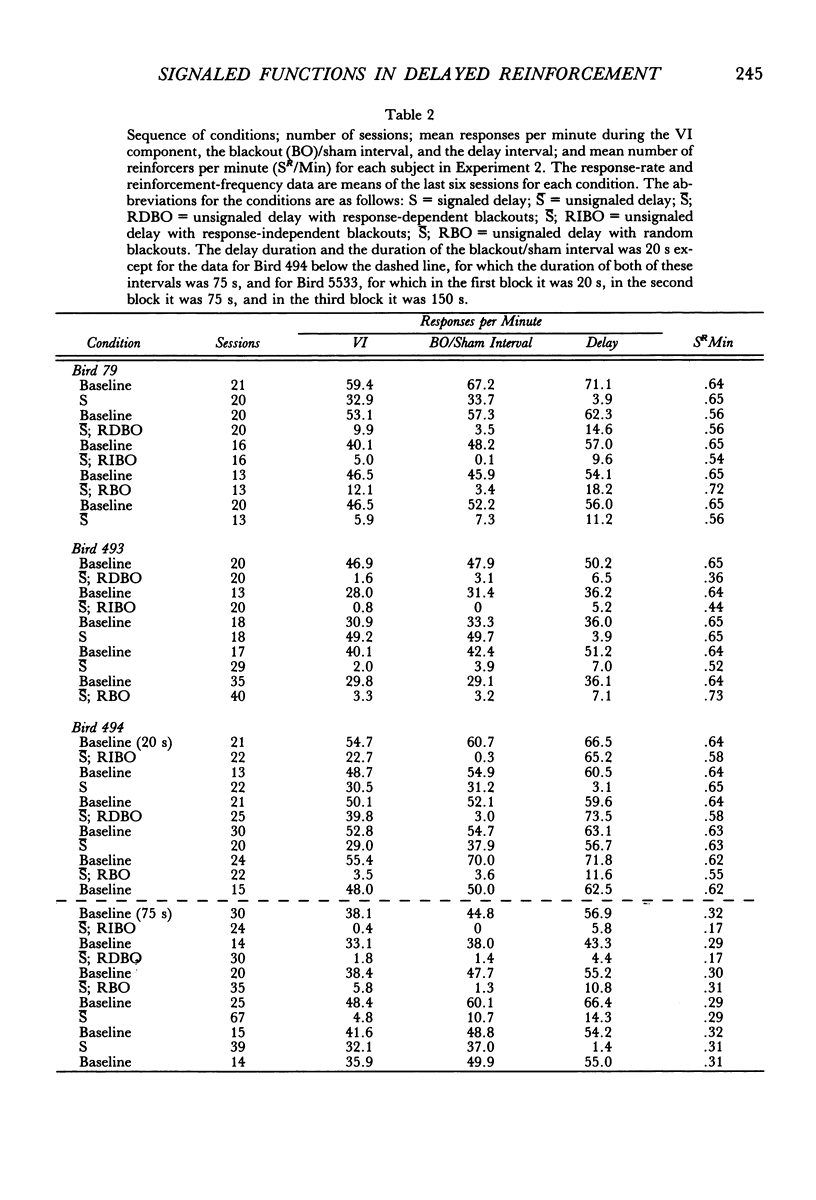
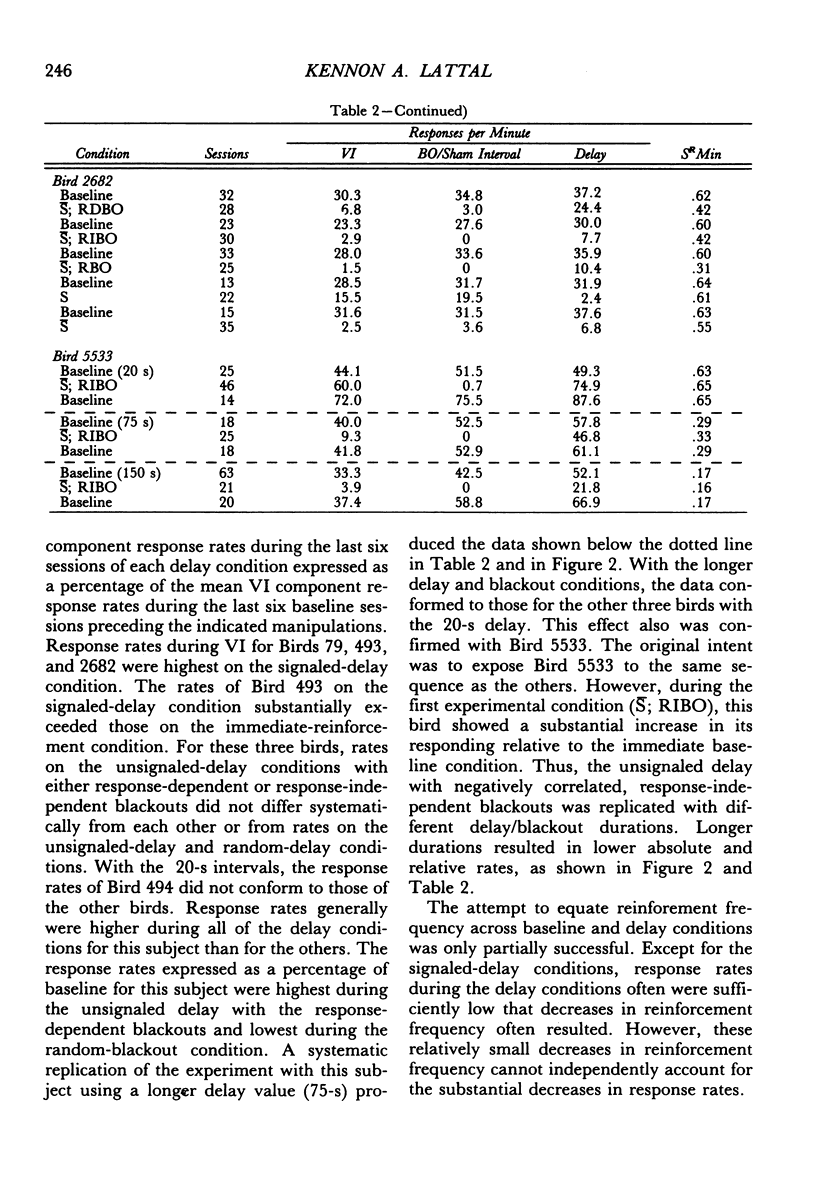

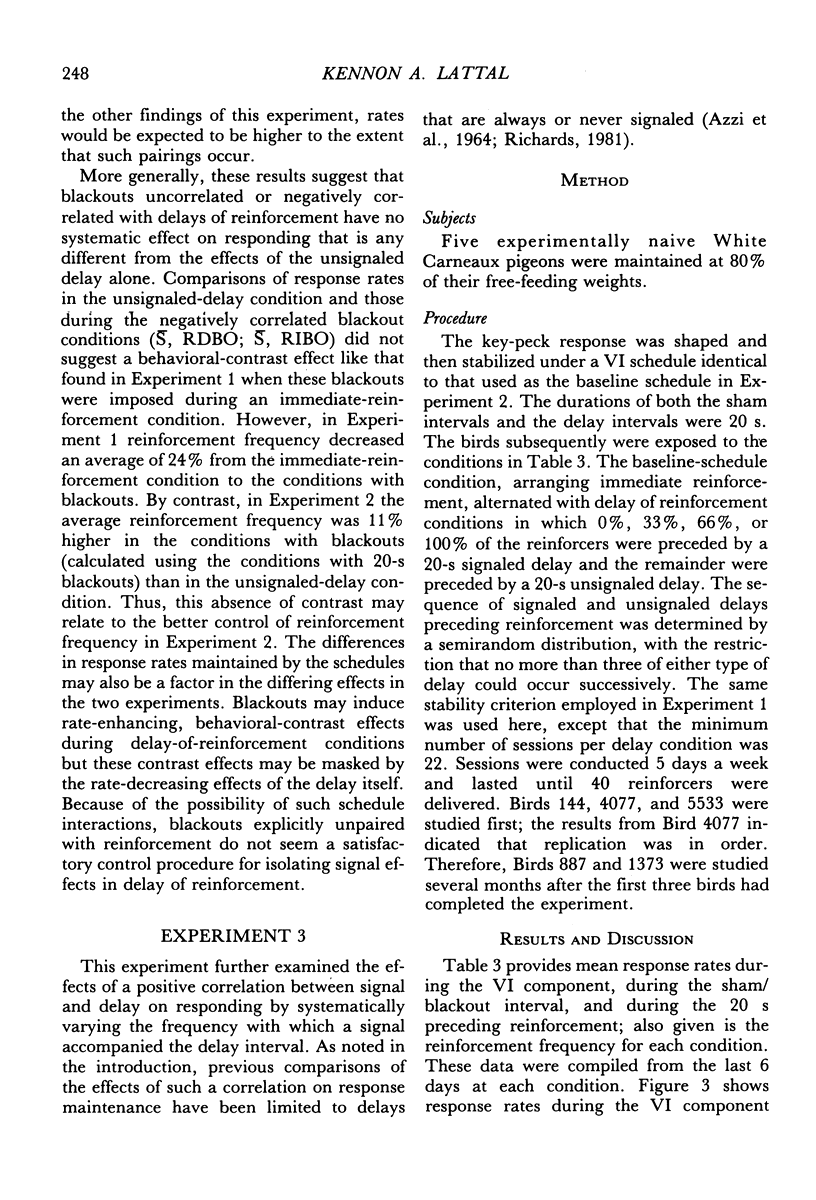
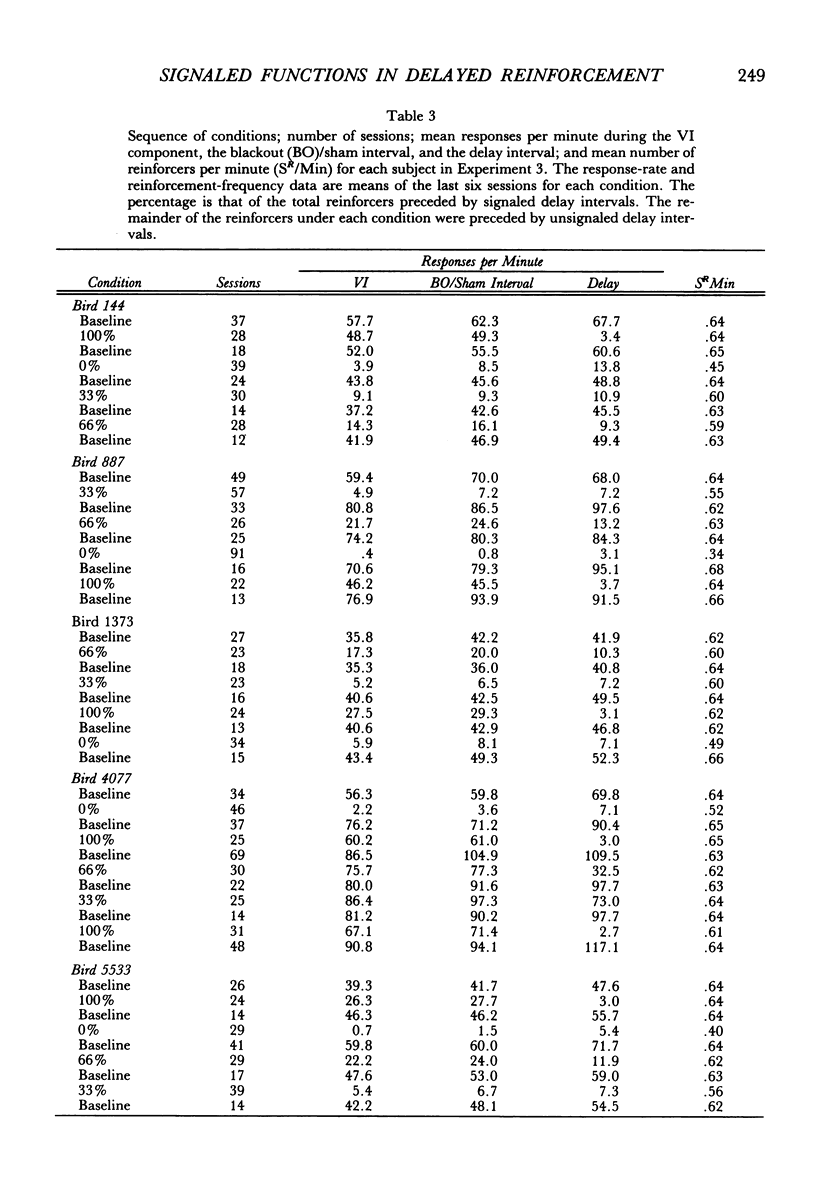
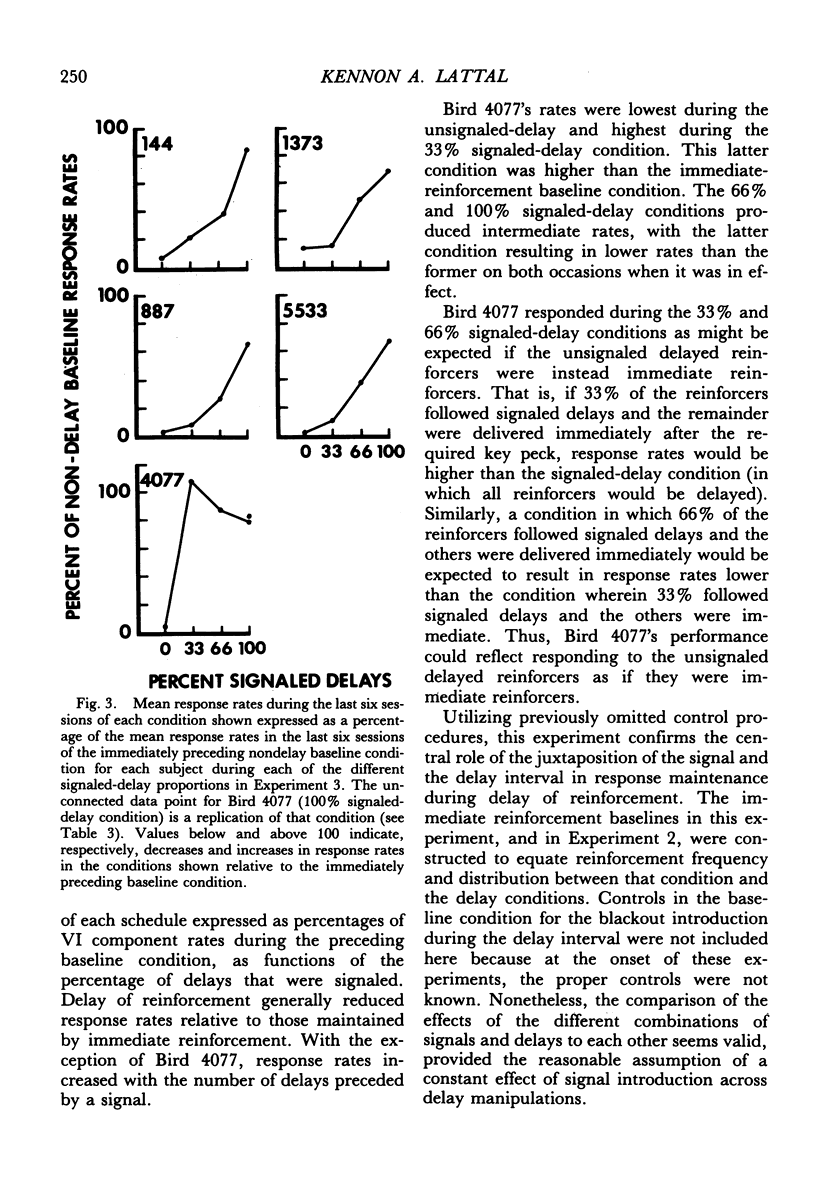
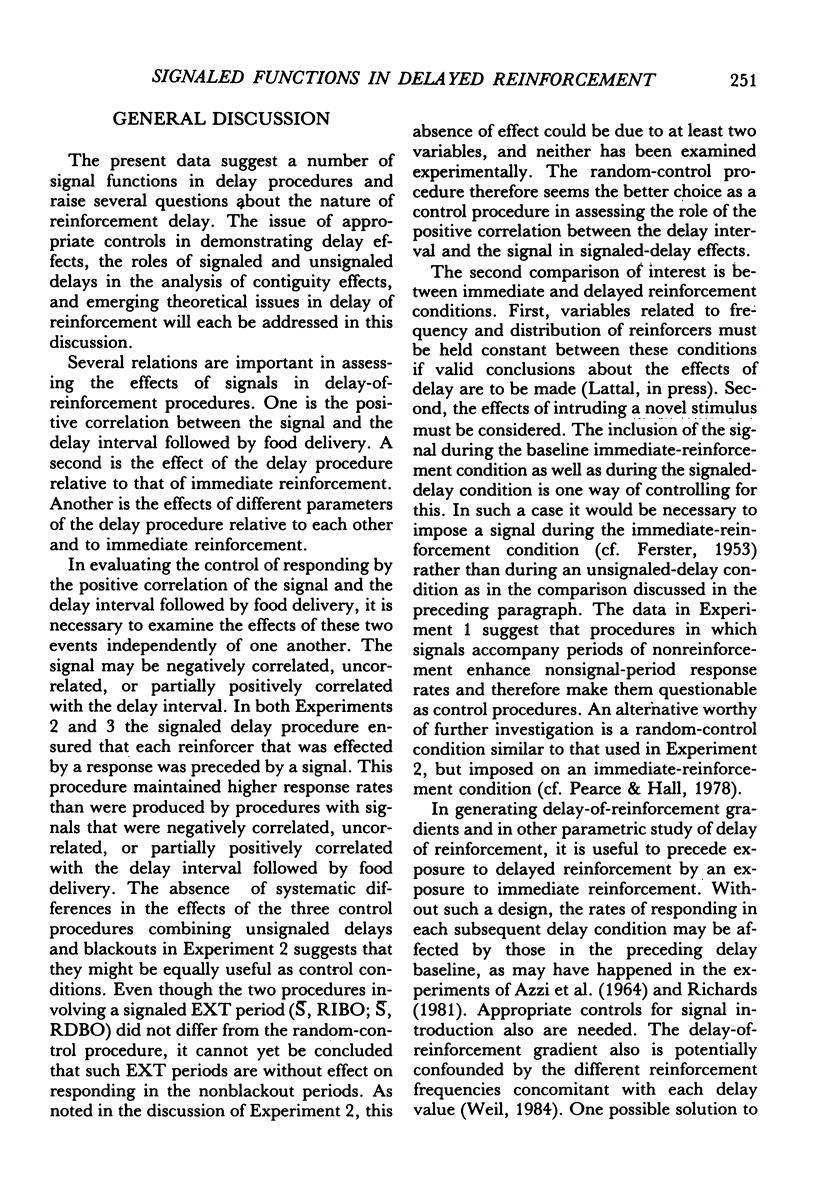
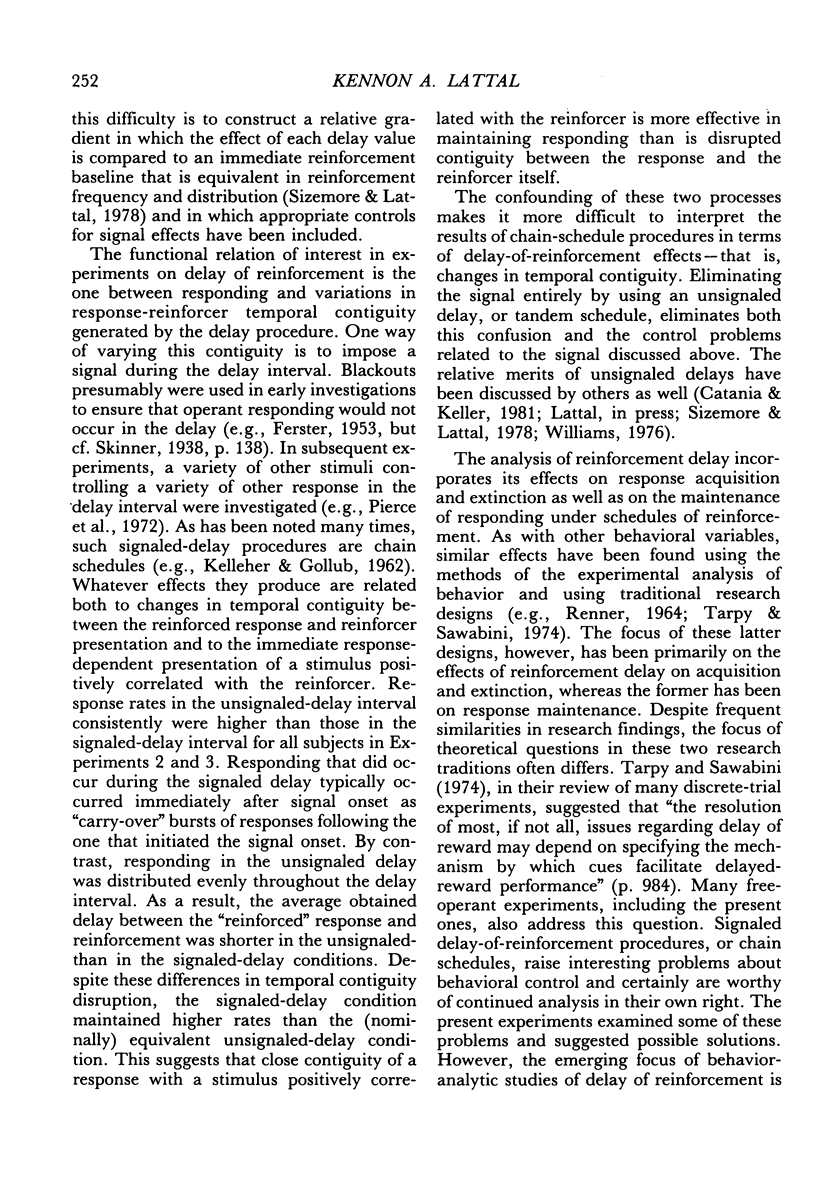

Selected References
These references are in PubMed. This may not be the complete list of references from this article.
- AZZI R., FIX D. S., KELLER F. S., ROCHAESILVA M. I. EXTEROCEPTIVE CONTROL OF RESPONSE UNDER DELAYED REINFORCEMENT. J Exp Anal Behav. 1964 Mar;7:159–162. doi: 10.1901/jeab.1964.7-159. [DOI] [PMC free article] [PubMed] [Google Scholar]
- Baum W. M. The correlation-based law of effect. J Exp Anal Behav. 1973 Jul;20(1):137–153. doi: 10.1901/jeab.1973.20-137. [DOI] [PMC free article] [PubMed] [Google Scholar]
- Catania A. C., Reynolds G. S. A quantitative analysis of the responding maintained by interval schedules of reinforcement. J Exp Anal Behav. 1968 May;11(3 Suppl):327–383. doi: 10.1901/jeab.1968.11-s327. [DOI] [PMC free article] [PubMed] [Google Scholar]
- Chung S. H. Effects of delayed reinforcement in a concurrent situation. J Exp Anal Behav. 1965 Nov;8(6):439–444. doi: 10.1901/jeab.1965.8-439. [DOI] [PMC free article] [PubMed] [Google Scholar]
- FERSTER C. B. Sustained behavior under delayed reinforcement. J Exp Psychol. 1953 Apr;45(4):218–224. doi: 10.1037/h0062158. [DOI] [PubMed] [Google Scholar]
- KELLEHER R. T., GOLLUB L. R. A review of positive conditioned reinforcement. J Exp Anal Behav. 1962 Oct;5:543–597. doi: 10.1901/jeab.1962.5-s543. [DOI] [PMC free article] [PubMed] [Google Scholar]
- Morgan M. J. Fixed-ratio performance under conditions of delayed reinforcement. J Exp Anal Behav. 1972 Jan;17(1):95–98. doi: 10.1901/jeab.1972.17-95. [DOI] [PMC free article] [PubMed] [Google Scholar]
- Pierce C. H., Hanford P. V., Zimmerman J. Effects of different delay of reinforcement procedures on variable-interval responding. J Exp Anal Behav. 1972 Jul;18(1):141–146. doi: 10.1901/jeab.1972.18-141. [DOI] [PMC free article] [PubMed] [Google Scholar]
- RENNER K. E. DELAYED OF REINFORCEMENT: A HISTORICAL REVIEW. Psychol Bull. 1964 May;61:341–361. doi: 10.1037/h0048335. [DOI] [PubMed] [Google Scholar]
- REYNOLDS G. S. Behavioral contrast. J Exp Anal Behav. 1961 Jan;4:57–71. doi: 10.1901/jeab.1961.4-57. [DOI] [PMC free article] [PubMed] [Google Scholar]
- Rescorla R. A. Pavlovian conditioning and its proper control procedures. Psychol Rev. 1967 Jan;74(1):71–80. doi: 10.1037/h0024109. [DOI] [PubMed] [Google Scholar]
- Richards R. W. A comparison of signaled and unsignaled delay of reinforcement. J Exp Anal Behav. 1981 Mar;35(2):145–152. doi: 10.1901/jeab.1981.35-145. [DOI] [PMC free article] [PubMed] [Google Scholar]
- Sadowsky S. Behavioral contrast with timeout, blackout, or extinction as the negative condition. J Exp Anal Behav. 1973 May;19(3):499–507. doi: 10.1901/jeab.1973.19-499. [DOI] [PMC free article] [PubMed] [Google Scholar]
- Sizemore O. J., Lattal K. A. Dependency, temporal contiguity, and response-independent reinforcement. J Exp Anal Behav. 1977 Jan;27(1):119–125. doi: 10.1901/jeab.1977.27-119. [DOI] [PMC free article] [PubMed] [Google Scholar]
- Sizemore O. J., Lattal K. A. Unsignalled delay of reinforcement in variable-interval schedules. J Exp Anal Behav. 1978 Sep;30(2):169–175. doi: 10.1901/jeab.1978.30-169. [DOI] [PMC free article] [PubMed] [Google Scholar]
- Weil J. L. The effects of delayed reinforcement on free-operant responding. J Exp Anal Behav. 1984 Mar;41(2):143–155. doi: 10.1901/jeab.1984.41-143. [DOI] [PMC free article] [PubMed] [Google Scholar]
- Williams B. A. The effects of unsignalled delayed reinforcement. J Exp Anal Behav. 1976 Nov;26(3):441–449. doi: 10.1901/jeab.1976.26-441. [DOI] [PMC free article] [PubMed] [Google Scholar]


